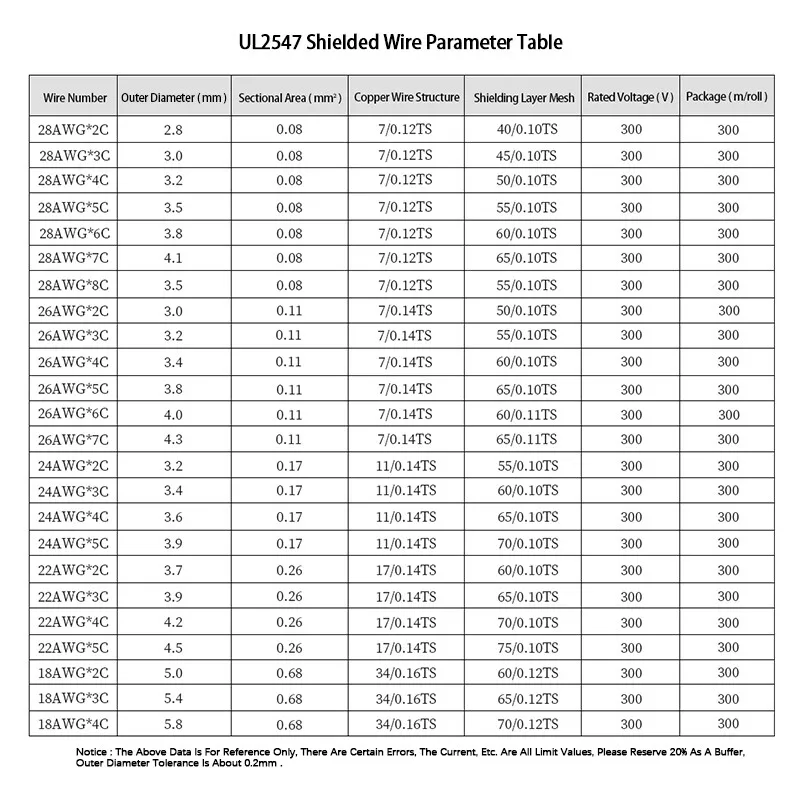1. Product core introduction
HomeDIYer presents this 2/3/4/5/6/8 multi-core shielded cable with 18/20/22 - 28AWG tinned copper signal wire and grey design for professional quality. Designed to meet all kinds of signal transmission needs, whether it's a simple home electronics connection or a slightly more complex small-scale industrial electrical projects, its excellent performance ensures stable and efficient signal transmission, and it is the DIY enthusiast's right-hand man in the field of electronics and electrical.
2. The main characteristics of the product
Flexible multi-core selection: provide 2 to 8-core configuration, the user can be based on the actual number of signal transmission line requirements, accurate selection of the appropriate number of cores, whether it is two basic signal transmission, or multiple complex data interaction, can be easily adapted to avoid waste of resources and over-configuration, to improve the project's economy and practicality.
High-quality tinned copper signal cable: The signal cable is made of tinned copper with excellent conductivity, which can effectively reduce signal attenuation, ensure signal integrity and clarity, and allow accurate data transmission. At the same time, the tinned layer enhances the antioxidant and corrosion resistance of the copper wire, which can work stably for a long period of time even in complex and changing environments, greatly prolonging the service life of the cables and reducing maintenance costs.
Precision AWG specifications: Covering 18/20/22 - 28AWG multiple precision specifications, different specifications correspond to specific wire diameter and electrical performance parameters. Users can accurately select the most suitable AWG gauge according to the signal transmission distance, the required current carrying capacity and the compatibility requirements of the equipment, ensuring that the cable meets the quality of the signal transmission, optimises the performance of the entire electrical system, and achieves the efficient use of resources and effective cost control.
Highly efficient shielding performance: Equipped with special shielding layer, it can effectively block external electromagnetic interference (EMI) and radio frequency interference (RFI), creating a stable and pure signal transmission environment for internal signal lines. This enables the cable to still reliably transmit weak signals in places with complex electromagnetic environments, such as factory floors, electronic equipment-intensive areas, and near communication base stations, which greatly reduces the probability of problems such as signal distortion and BER, ensures the accuracy and reliability of data transmission, and improves the overall stability of the system.
3. Product use scene
Smart home system construction and upgrading: in the connection of smart home equipment, such as intelligent lighting system, intelligent curtain motor, intelligent security cameras, intelligent door locks and other equipment signal transmission, the multi-core structure and shielding performance of this cable can ensure the stable transmission of all kinds of control signals and feedback signals, avoid signal interference caused by equipment misoperation, so that the smart home system runs more smoothly and reliably, providing users with a more convenient and comfortable smart life experience. Provide users with a more convenient and comfortable smart life experience.
Internal connection of electronic instruments and equipment: For precision electronic instruments, such as oscilloscopes, signal generators, spectrum analysers, electronic microscopes, etc., their complex internal circuit systems require high-quality signal transmission cables. The tinned copper signal wire and shielding layer of this cable can meet the requirements of high sensitivity detection and precise analysis of weak electrical signals of the instruments, ensure the stable performance of the instruments, and provide reliable signal transmission guarantee for the professionals in the fields of scientific research, teaching, electronic research and development, etc., and help them explore and innovate in the field of electronics.
Small industrial automation control: In the automated production line of small factories, it is used to connect the signal lines between various types of sensors (such as temperature sensors, pressure sensors, position sensors, etc.), controllers (such as PLC, microcontrollers, etc.) and actuators (such as motors, solenoid valves, etc.). Its multi-core shielded cable can accurately and timely transmit various control and feedback signals in the complex industrial electromagnetic environment, ensure the efficient and stable operation of the production line, improve production efficiency and product quality, and provide strong support for the development of small industrial enterprises.
Audio-video equipment connection: In the wiring of audio-video equipment such as home theatre systems, professional recording studios, broadcasting stations, etc., this cable can be used to connect the audio and video signal transmission between speakers, amplifiers, mixing consoles, cameras, video monitors and other equipment. Its good shielding performance can effectively prevent the influence of external electromagnetic interference on the audio and video signals, to ensure high-fidelity reproduction of sound and video images clear and stable transmission, to bring users high-quality audio-visual enjoyment.
4. Product use instructions
Preparation before installation:
Carefully check the appearance of the cable for defects such as breakage, scratches, flattening, etc., especially whether the shielding layer is intact. If any problem is found, stop using it immediately and contact the supplier for replacement.
Determine the number of cable cores and AWG specifications required according to the actual use scenarios and equipment connection requirements, and prepare the corresponding connection terminals, wire stripping tools, crimping pliers, soldering iron (if soldering is required) and other installation tools to ensure the accuracy and applicability of the tools, so as to avoid damage to the cable in the installation process.
Wiring and connection:
In the wiring process, the cable should be reasonably planned according to the actual installation path and environmental conditions to avoid excessive bending, twisting or stretching the cable.
When connecting with the equipment, first use the wire stripping tool to carefully peel off the insulation layer at the end of the cable, exposing the appropriate length of tinned copper signal wire, and then insert the signal wire into the connecting terminal, and use the crimping pliers to firmly press it, to ensure that the connection is reliable and the contact is good. If soldered connections are required, use suitable solder and soldering techniques to ensure that the solder joints are firm, smooth and free of false soldering. After the connection is completed, the connection is carefully insulated and can be wrapped with insulating tape or heat-shrinkable tubing to prevent leakage and short-circuit accidents.
Precautions for use:
The rated voltage and current of this cable should be used in strict accordance with the parameters on the product specification, and shall not exceed the maximum value specified therein, so as not to cause electrical safety accidents or affect the quality of signal transmission. When connecting multiple devices, pay attention to calculating the total power and current to ensure that the cable can withstand the load.
Avoid exposing the cable to harsh environmental conditions such as high temperatures, open flames, humidity and corrosive chemicals. If the cables need to be used in special environments, such as outdoors, high temperature workshops or chemical sites, appropriate protective measures should be taken, such as the use of fireproof, waterproof and corrosion-resistant wire ducts or casings to protect the cables, in order to prolong the service life of the cables and to ensure the stability of their performance.
Regularly check the connection parts and overall appearance of the cable to see if there is any looseness, oxidation, breakage and so on. If problems are found, they should be repaired or replaced in time to ensure the normal operation of the cable and the reliability of signal transmission. At the same time, when carrying out equipment maintenance or overhaul, attention should be paid to protecting the cable to avoid damage caused by human factors.

















